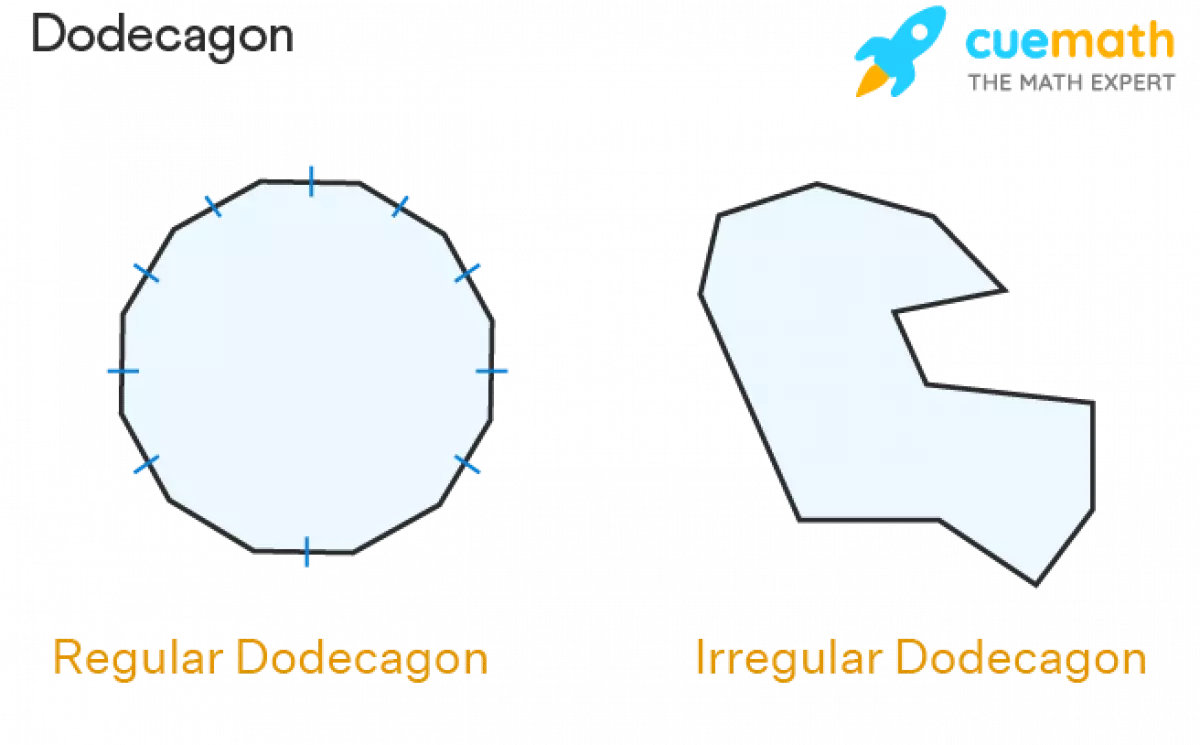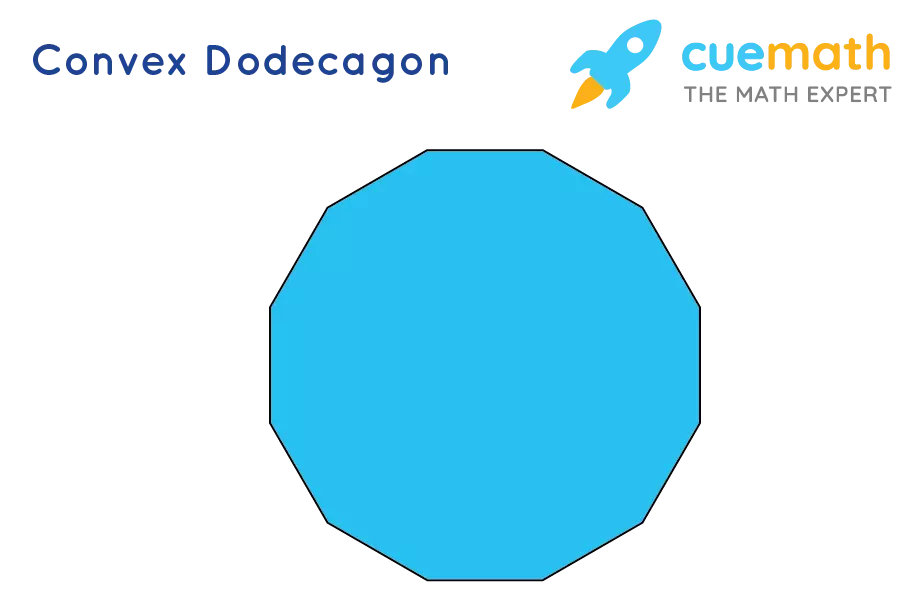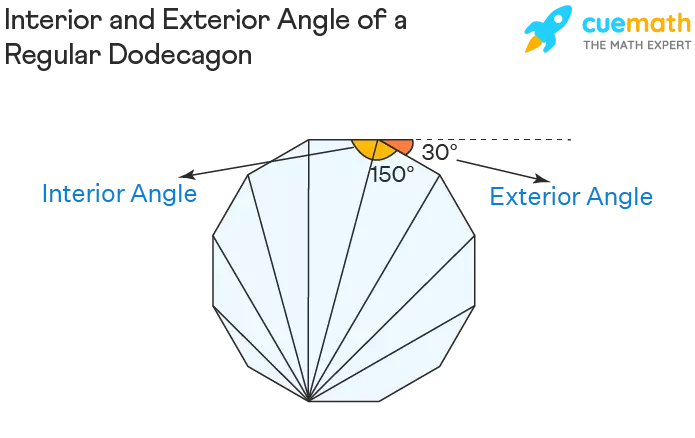Have you ever heard of a dodecagon? It might sound like a complex mathematical term, but it's actually quite fascinating. In this article, we'll delve into the world of dodecagons, exploring their different types, properties, and even calculating their perimeter and area. So, let's unlock the secrets of this intriguing polygon together!
What is a Dodecagon?
First things first, let's define what a dodecagon actually is. In simple terms, a dodecagon is a polygon with 12 sides, 12 angles, and 12 vertices. The word "dodecagon" originates from the Greek words "dōdeka" meaning 12, and "gōnon" meaning angle. As you can imagine, this polygon can take various forms, including regular, irregular, concave, or convex, based on its unique properties.
 Image: A regular dodecagon and an irregular dodecagon
Image: A regular dodecagon and an irregular dodecagon
Types of Dodecagons
Dodecagons come in different types, each distinguished by the measurements of their sides, angles, and other properties. Let's explore the main types of dodecagons:
Regular Dodecagon
A regular dodecagon exhibits symmetry, with all 12 sides having equal lengths and all angles measuring the same. It is a beautifully balanced polygon. Refer to the first image above to see an example of a regular dodecagon.
Irregular Dodecagon
On the other hand, irregular dodecagons possess sides and angles of different measures. There is an infinite number of variations, meaning each irregular dodecagon appears distinct from the others, even though they all share the common 12-sided structure. Take a look at the second image above to visualize an irregular dodecagon.
Concave Dodecagon
In a concave dodecagon, at least one of the interior angles measures greater than 180°. Additionally, the vertices of a concave dodecagon can be either inward or outward, creating an intriguing visual effect.

Convex Dodecagon
Conversely, a convex dodecagon showcases angles that are all smaller than 180°, with no inward-facing vertices. The resulting shape is both captivating and aesthetically pleasing.

Properties of a Dodecagon
Now that we've explored the different types of dodecagons, let's dive into their intriguing properties. Understanding these properties will help us appreciate the inner workings of this captivating polygon. Here are the key properties worth noting:
-
Each interior angle of a regular dodecagon measures 150°. This can be calculated using the formula: (180n - 360) / n, where n represents the number of sides. For a dodecagon, n equals 12, so substituting the values yields: (180 * 12 - 360) / 12 = 150°.
-
The sum of the interior angles of a dodecagon can be calculated using the formula (n - 2) × 180°. For a dodecagon, with n being 12, the sum of the interior angles equals (12 - 2) × 180° = 1800°.

-
Each exterior angle of a regular dodecagon measures 30°. Observing the figure above, we can see that the exterior angle and interior angle together form a straight angle (180°). Therefore, the exterior angle can be calculated as 180° - 150° = 30°. Consequently, the sum of the exterior angles in a regular dodecagon is 360°.
-
A dodecagon possesses 54 distinct diagonals. The formula to calculate the number of diagonals in a polygon is 1/2 × n × (n-3), where n represents the number of sides. Applying this formula to a dodecagon, where n is 12, we get: 1/2 × 12 × (12-3) = 54 diagonals.
-
The diagonals of a dodecagon also create 10 triangles. The number of triangles formed by the diagonals can be calculated using the formula (n - 2), where n is the number of sides. For a dodecagon, with n being 12, the number of triangles formed is 12 - 2 = 10.
To summarize, here's a table recollecting the key properties of a dodecagon we've discussed:
| Property | Value |
|---|---|
| Each Interior Angle | 150° |
| Each Exterior Angle | 30° |
| Number of Diagonals | 54 |
| Number of Triangles | 10 |
| Sum of Interior Angles | 1800° |
Perimeter and Area of a Dodecagon
Now that we understand the properties of a dodecagon, let's delve into calculating its perimeter and area. These calculations will help us grasp the spatial dimensions and magnitude of this intriguing polygon.
The perimeter of a regular dodecagon can be found by either summing the lengths of all its sides or multiplying the length of one side by the total number of sides. Based on the formula P = s × 12, where 's' represents the length of one side, let's assume the side of a regular dodecagon measures 10 units. Therefore, the perimeter will be: 10 × 12 = 120 units.
To determine the area of a regular dodecagon, the formula A = 3 × (2 + √3) × s^2 comes into play. In this formula, A refers to the area of the dodecagon, and 's' corresponds to the length of its side. For instance, let's assume the side of a regular dodecagon measures 8 units. Substituting this value into the formula, we get:
A = 3 × (2 + √3) × 8^2
Calculating further, the area of this dodecagon is approximately 716.554 square units.
Important Tips on Dodecagons
To ensure a smooth journey into the world of dodecagons, here are a few essential tips to keep in mind:
- A dodecagon is a polygon with 12 sides, 12 angles, and 12 vertices.
- The sum of the interior angles of a dodecagon is 1800°.
- The area of a regular dodecagon is calculated using the formula: A = 3 × (2 + √3) × s^2.
- The perimeter of a dodecagon is calculated using the formula: P = s × 12.
By understanding these fundamentals, you'll be well-equipped to tackle any problem related to dodecagons confidently.
Conclusion
Congratulations! You've embarked on an exciting exploration of dodecagons, uncovering their various types, properties, and even calculating their perimeter and area. Now that you possess this newfound knowledge, you can confidently navigate the intricate world of polygons. Remember, dodecagons are just one piece of the fascinating puzzle. Keep on exploring and unraveling the mysteries of mathematics!
Related Articles: Types of Polygon, Pentagon, Hexagon, Heptagon, Octagon, Decagon, Dodecahedron

















